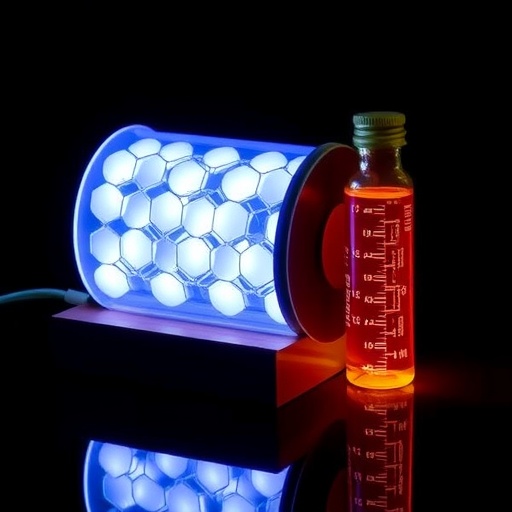In the quest for efficient energy storage, lithium-ion batteries continue to dominate the market, with their extensive use in electric vehicles and portable electronics. As researchers push for improvements, the focus has shifted towards enhancing the longevity and stability of battery components. One significant advancement has emerged from a study conducted by Wang, H., Lv, L., Zhang, H., and their team, revealing promising results in enhancing the long-term stability of the high-voltage cathode LiCoO₂. The use of nitrile electrolyte additives played a crucial role in this breakthrough, showcasing their potential to revolutionize battery technology.
Lithium cobalt oxide, commonly known as LiCoO₂, is a well-known cathode material in lithium-ion batteries. Its high energy density and stable cycling performance make it a favorite among battery manufacturers. However, the challenge arises when attempting to maintain its performance over extended periods, particularly at high voltages. The degradation of voltage and capacity over time could limit the usability of electric vehicles and portable devices, leading to a pressing need for innovative solutions to enhance battery longevity.
One of the critical findings in this research is the ability of nitrile electrolyte additives to mitigate the adverse effects that commonly plague high-voltage operation. Traditionally, lithium-ion batteries face challenges such as electrolyte decomposition and the formation of undesirable solid electrolyte interphase (SEI) layers. These issues can lead to capacity fade and reduced performance over time. By incorporating nitrile additives into the electrolyte composition, the researchers observed an enhancement in electrochemical stability and reduced degradation.
The use of nitrile-based additives not only improved the battery’s performance but also influenced the chemical interactions at the electrode-electrolyte interface. As the team conducted a series of experiments, they meticulously compared the performance of LiCoO₂ electrodes with and without the nitrile additives. The results were compelling; those with the nitrile additives demonstrated better retention of capacity and higher coulombic efficiency. This finding suggests that the nitrile compounds might significantly alter the SEI formation process, thereby showcasing their potential as a vital component in high-voltage lithium-ion batteries.
Furthermore, the influence of nitrile additives on battery cycle life was profound. Over an extended number of charge-discharge cycles, the stability of the LiCoO₂ cathode significantly increased, allowing it to maintain a high performance level throughout. This is particularly important for applications requiring durability, such as electric vehicles, where battery replacements can incur substantial costs and inconvenience. The ability to harness the benefits of nitrile additives may ultimately lead to longer-lasting batteries that can withstand the rigors of everyday use.
The implications of this study extend beyond just the confines of laboratory results. The automotive industry, in particular, stands to benefit immensely from improved battery technology. With the global push towards electrification, manufacturers are on a relentless quest to enhance battery performance. By adopting nitrile additives in their battery production, they may be able to offer consumers longer-lasting and more efficient electric vehicles, addressing one of the significant concerns regarding range anxiety and overall performance.
Moreover, the environmental aspect cannot be overlooked. As lithium-ion batteries remain one of the most widely used energy storage systems, finding ways to extend their service life helps reduce electronic waste. Nitrile additives, by enhancing battery stability, contribute to a more sustainable future, aligning with global efforts to minimize the environmental impact of battery production and disposal.
Collaboration and knowledge sharing among researchers, industry professionals, and battery manufacturers will be crucial in advancing this field. By leveraging these findings, the broader scientific community can work towards integrating nitrile additives into existing battery technologies, paving the way for wider adoption and further innovation. This collaborative spirit can ensure that advancements in the lab translate into real-world applications that benefit consumers and industries alike.
To comprehend the full impact of these breakthroughs, continuous evaluation and testing are necessary. As the researchers behind this study continue their investigations, they aim to explore other potential additives that may work synergistically with nitrile compounds to push the boundaries of battery technology even further. The ongoing pursuit of knowledge ensures that the field remains dynamic, with the potential for new discoveries that could radically change the landscape of energy storage solutions as we know it.
Essentially, the work done by Wang, H. and their colleagues is a testament to the power of innovation in overcoming the challenges faced by lithium-ion batteries. The utilization of nitrile electrolyte additives can set a new standard for performance and reliability, reinforcing the idea that the future of energy storage will be defined by continued advancements in material science and chemistry.
In conclusion, the study brings to light a significant advancement in the quest for longer-lasting lithium-ion batteries. By highlighting the benefits of nitrile additives in enhancing the stability of high-voltage LiCoO₂ cathodes, this research not only propels us closer to developing batteries that meet the growing needs of modern technology but also aligns with global sustainability goals. As we strive for a greener future, advancements such as these can pave the way for innovative solutions, making electric vehicles and portable electronics more efficient and environmentally friendly than ever before. The journey of exploration in energy storage technology is far from over, and the results of this study may be just the beginning of a new era in battery development.
Subject of Research: Long-cycle stability of high-voltage LiCoO₂ cathode by nitrile electrolyte additives.
Article Title: Long-cycle stability of high-voltage LiCoO₂ cathode by nitrile electrolyte additives.
Article References: Wang, H., Lv, L., Zhang, H. et al. Long-cycle stability of high-voltage LiCoO₂ cathode by nitrile electrolyte additives. Ionics (2025). https://doi.org/10.1007/s11581-025-06690-7
Image Credits: AI Generated
DOI: https://doi.org/10.1007/s11581-025-06690-7
Keywords: Lithium-ion batteries, LiCoO₂, nitrile additives, battery stability, cycle life, electrification, sustainability.




